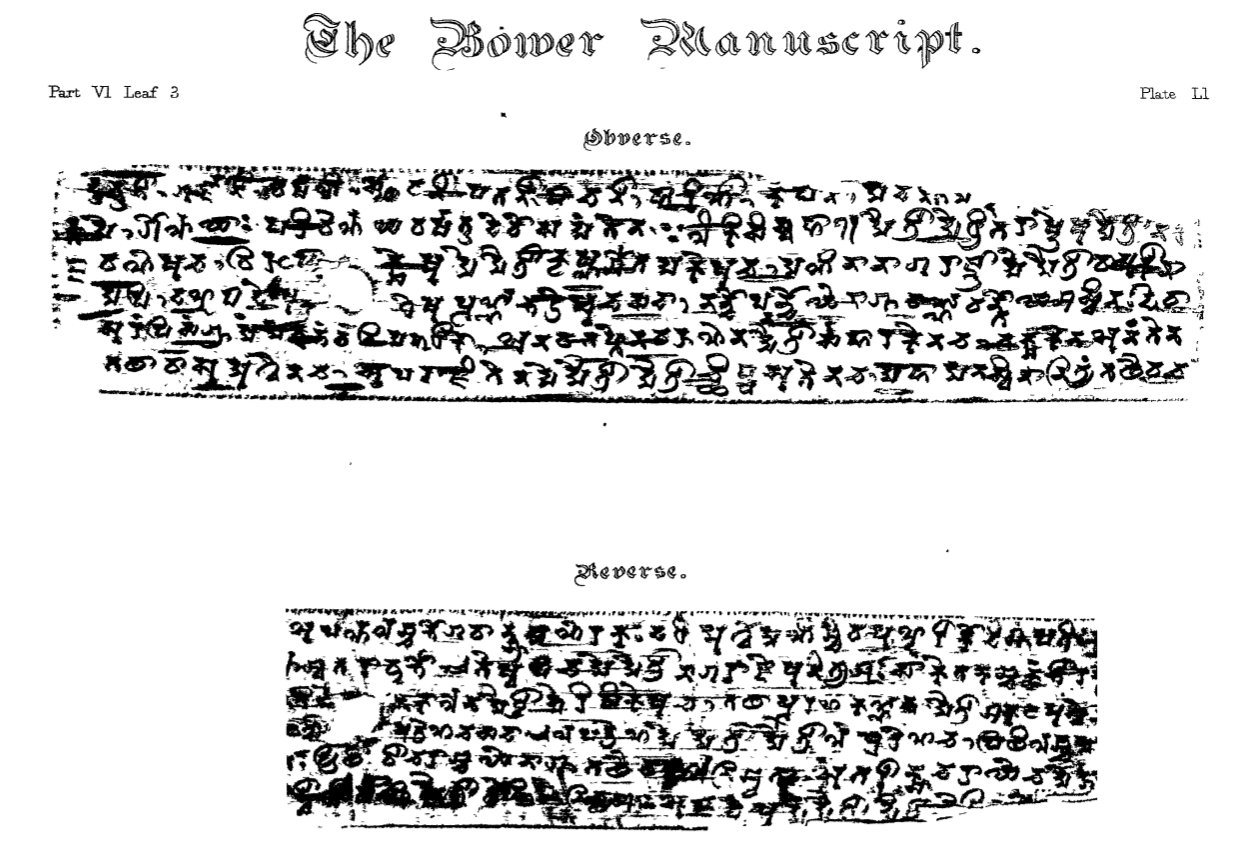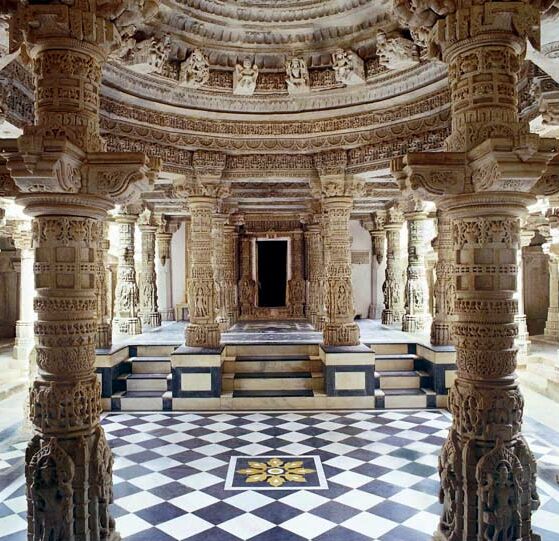|
Pothi
Palm-leaf manuscripts are manuscripts made out of dried palm leaves. Palm leaves were used as writing materials in the Indian subcontinent and in Southeast Asia dating back to the 5th century BCE. Their use began in South Asia and spread to other regions, as texts on dried and smoke-treated palm leaves of the Palmyra or talipot palm. Their use continued until the 19th century when printing presses replaced hand-written manuscripts. One of the oldest surviving palm leaf manuscripts of a complete treatise is a Sanskrit Shaivism text from the 9th century, discovered in Nepal, and now preserved at the Cambridge University Library.Pārameśvaratantra (MS Add.1049.1) with images , Puṣkarapārameśvaratantra, University of Cambridge (2015) The |
Bower Manuscript
The Bower Manuscript is a collection of seven fragmentary Sanskrit treatises found buried in a Buddhism, Buddhist memorial stupa near Kucha, northwestern China. Written in early Gupta script (late Brahmi ) on birch bark document, birch bark, it is variously dated in 5th to early 6th century.L Sander (1987), ''Origin and date of the Bower Manuscript, a new approach'', in: M Yaldiz and W Lobo (eds.): Investigating the Indian Arts, Museum für Indische Kunst, Berlin, pp. 313–323 The Bower manuscript includes the oldest dated fragments of an Indian medical text, the ''Navanitaka''. The seven treatises included in the collection three on Ayurveda, Ayurvedic medicine, two on divination by dice, and two on incantations (Dharani) against snake bites. The collection had at least four scribes, of which three were likely Buddhists because the second, the sixth and the seventh treatises open by invoking the Buddha and other Buddhist deities. Two invoke Shiva, Vishnu, Devi, and other Hindu ... [...More Info...] [...Related Items...] OR: [Wikipedia] [Google] [Baidu] |
Spitzer Manuscript
The Spitzer Manuscript is the oldest surviving philosophical manuscript in Sanskrit, and possibly the oldest discovered Sanskritic manuscript of any type related to Hinduism or may be Buddhism. The manuscript was found in 1906 in the form of a pile of more than 1,000 palm leaf fragments in the Ming-oi, Kizil Caves, China during the third Turfan expedition headed by Albert Grünwedel. It is named after Moritz Spitzer, whose team first studied it in 1927–28. The calibrated age by Carbon-14 technique is 130 CE (80–230 CE). According to Indologist Eli Franco, palaeographical features suggest a date closer to 200–230 CE. The text is written in the Brahmi script (Kushana period) and some early Gupta script. The Spitzer Manuscript was found near the northern branch of the Central Asian Silk Road. It is unique in a number of ways. Unlike numerous Indian manuscripts whose copies survive as early translations in Tibet and China, no such translations of the treatises within the Sp ... [...More Info...] [...Related Items...] OR: [Wikipedia] [Google] [Baidu] |
Sinhala Palm-leaf Medical Manuscripts, Open Leaves, Large Image
Sinhala may refer to: * Sinhala or Sinhala dvipa, another name of Sri Lanka * Sinhalese people, an ethno-linguistic group native to Sri Lanka * Sinhala language, the native language of the Sinhalese people * Sinhala script, the writing system of the Sinhala language ** Sinhala (Unicode block), a block of Sinhala characters in Unicode * Sinhala cinema, cinema in the Sinhala language * Sinhala Kingdom, the successive historical Sinhalese kingdoms of Sri Lanka between 543 BCE and 1815 CE * "Sinhala", a song from the 1999 album ''The Magical Sounds of Banco de Gaia'' See also * Sinha, an Indian name ** Sinha (surname), an Indian surname * Simha (other) * Singam (other) * Singham (other) * Singa (other) * Singhania (other) * Singh Singh ( IPA: ) is a title, middle name, or surname that means "lion" in various South Asian and Southeast Asian communities. Traditionally used by the Hindu Kshatriya community, it was later mandated in t ... [...More Info...] [...Related Items...] OR: [Wikipedia] [Google] [Baidu] |
Indonesia
Indonesia, officially the Republic of Indonesia, is a country in Southeast Asia and Oceania, between the Indian Ocean, Indian and Pacific Ocean, Pacific oceans. Comprising over List of islands of Indonesia, 17,000 islands, including Sumatra, Java, Sulawesi, and parts of Borneo and New Guinea, Indonesia is the world's largest archipelagic state and the List of countries and dependencies by area, 14th-largest country by area, at . With over 280 million people, Indonesia is the world's List of countries and dependencies by population, fourth-most-populous country and the most populous Islam by country, Muslim-majority country. Java, the world's List of islands by population, most populous island, is home to more than half of the country's population. Indonesia operates as a Presidential system, presidential republic with an elected People's Consultative Assembly, legislature and consists of Provinces of Indonesia, 38 provinces, nine of which have Autonomous administrative divisi ... [...More Info...] [...Related Items...] OR: [Wikipedia] [Google] [Baidu] |
Jain Temple
A Jain temple, Derasar (Gujarati: દેરાસર) or Basadi (Kannada: ಬಸದಿ) is the place of worship for Jains, the followers of Jainism. Jain architecture is essentially restricted to temples and monasteries, and Jain buildings generally reflect the prevailing style of the place and time they were built. Jain temple architecture is generally close to Hindu temple architecture, and in ancient times Buddhist architecture. Normally the same builders and carvers worked for all religions, and regional and periodic styles are generally similar. For over 1,000 years, the basic layout of a Hindu or most Jain temples has consisted of a small garbhagriha or sanctuary for the main murti or idol, over which the high superstructure rises, then one or more larger mandapa halls. Māru-Gurjara architecture or the "Solanki style", is a particular temple style from Gujarat and Rajasthan (both regions with a strong Jain presence) that originated in both Hindu and Jain temples a ... [...More Info...] [...Related Items...] OR: [Wikipedia] [Google] [Baidu] |
Grammar
In linguistics, grammar is the set of rules for how a natural language is structured, as demonstrated by its speakers or writers. Grammar rules may concern the use of clauses, phrases, and words. The term may also refer to the study of such rules, a subject that includes phonology, morphology (linguistics), morphology, and syntax, together with phonetics, semantics, and pragmatics. There are, broadly speaking, two different ways to study grammar: traditional grammar and #Theoretical frameworks, theoretical grammar. Fluency in a particular language variety involves a speaker internalizing these rules, many or most of which are language acquisition, acquired by observing other speakers, as opposed to intentional study or language teaching, instruction. Much of this internalization occurs during early childhood; learning a language later in life usually involves more direct instruction. The term ''grammar'' can also describe the linguistic behaviour of groups of speakers and writer ... [...More Info...] [...Related Items...] OR: [Wikipedia] [Google] [Baidu] |
Poetry
Poetry (from the Greek language, Greek word ''poiesis'', "making") is a form of literature, literary art that uses aesthetics, aesthetic and often rhythmic qualities of language to evoke meaning (linguistics), meanings in addition to, or in place of, Denotation, literal or surface-level meanings. Any particular instance of poetry is called a poem and is written by a poet. Poets use a variety of techniques called poetic devices, such as assonance, alliteration, Phonaesthetics#Euphony and cacophony, euphony and cacophony, onomatopoeia, rhythm (via metre (poetry), metre), and sound symbolism, to produce musical or other artistic effects. They also frequently organize these effects into :Poetic forms, poetic structures, which may be strict or loose, conventional or invented by the poet. Poetic structures vary dramatically by language and cultural convention, but they often use Metre (poetry), rhythmic metre (patterns of syllable stress or syllable weight, syllable (mora) weight ... [...More Info...] [...Related Items...] OR: [Wikipedia] [Google] [Baidu] |
Hindu Philosophy
Hindu philosophy or Vedic philosophy is the set of philosophical systems that developed in tandem with the first Hinduism, Hindu religious traditions during the Iron Age in India, iron and Classical India, classical ages of India. In Indian philosophy, of which Hindu philosophy is a prominent subset, the word used for philosophy is ''Darshana'' (Sanskrit: दर्शन; meaning: "viewpoint or perspective"), from the Sanskrit root 'दृश' () meaning 'to see, to experience'. The schools of thought or ''Darshanas'' within Hindu philosophy largely equate to the six ancient orthodox schools: the ''Āstika and nāstika, āstika'' (Sanskrit: आस्तिक) schools, defined by their acceptance of the Vedas, the oldest collection of Sanskrit literature, Sanskrit texts, as an authoritative source of knowledge. Of these six, Samkhya (सांख्य) is the earliest school of Dualism (Indian philosophy), dualism; Yoga (philosophy), Yoga (योग) combines the metaphysics ... [...More Info...] [...Related Items...] OR: [Wikipedia] [Google] [Baidu] |
Matha
A ''matha'' (; , ), also written as ''math'', ''muth'', ''mutth'', ''mutt'', or ''mut'', is a Sanskrit word that means 'institute or college', and it also refers to a monastery in Hinduism.Matha Encyclopædia Britannica Online 2009 An alternative term for such a monastery is ''adheenam''. The earliest epigraphical evidence for ''mathas'' related to Hindu-temples comes from the 7th to 10th century CE. The most famous Advaita Vedanta ''mathas'' or ''peethams'', which came to be affiliated with the Advaita tradition in the 14th century, are Govardhanmaṭha Pīṭhaṃ at |
Metropolitan Museum Of Art
The Metropolitan Museum of Art, colloquially referred to as the Met, is an Encyclopedic museum, encyclopedic art museum in New York City. By floor area, it is the List of largest museums, third-largest museum in the world and the List of largest art museums, largest art museum in the Americas. With 5.36 million visitors in 2023, it is the List of most-visited museums in the United States, most-visited museum in the United States and the List of most-visited art museums, fifth-most visited art museum in the world. In 2000, its permanent collection had over two million works; it currently lists a total of 1.5 million works. The collection is divided into 17 curatorial departments. The Met Fifth Avenue, The main building at 1000 Fifth Avenue, along the Museum Mile, New York, Museum Mile on the eastern edge of Central Park on Manhattan's Upper East Side, is by area one of the world's list of largest art museums, largest art museums. The first portion of the approximately building ... [...More Info...] [...Related Items...] OR: [Wikipedia] [Google] [Baidu] |
Hindu Temple
A Hindu temple, also known as Mandir, Devasthanam, Pura, or Kovil, is a sacred place where Hindus worship and show their devotion to Hindu deities, deities through worship, sacrifice, and prayers. It is considered the house of the god to whom it is dedicated.; Quote: "The Hindu temple is designed to bring about contact between man and the gods of Hinduism religion" (...) "The architecture of the Hindu temple symbolically represents this quest by setting out to dissolve or decrease the boundaries between man and the divine". Hindu temple architecture, which makes extensive use of squares and circles, has its roots in later Vedic traditions, which also influence the temples' construction and symbolism. Through astronomical numbers and particular alignments connected to the temple's location and the relationship between the deity and the worshipper, the temple's design also illustrates the idea of recursion and the Microcosm–macrocosm analogy, equivalency of the macrocosm and t ... [...More Info...] [...Related Items...] OR: [Wikipedia] [Google] [Baidu] |






